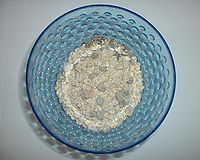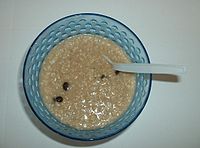Oatmeal
This article needs additional citations for verification. (October 2008) |
  |
Oatmeal is a product of ground oat groats (i.e. oat-meal, cf. cornmeal, peasemeal, etc.) or a porridge made from this product (also called oatmeal cereal). In the United States and Canada, 'oatmeal' can refer also to other products made from oat groats, such as cut oats, crushed oats, and rolled oats. The groats are coarsely ground to make oatmeal, or cut into small pieces to make steel-cut oats, or steamed and rolled to make rolled oats. The quick-cooking rolled oats ("quick oats") are cut into small pieces before being steamed and rolled. "Instant" oatmeal is pre-cooked and dried, usually with sweetener and flavor additives.[1] Oatmeal is used to make porridge, as an ingredient as in oatmeal cookies and oat cakes, or as an accent as in the topping on many oat bran breads and the coating on Caboc cheese. It is also used as a thickener in some foods such as canned chili con carne. Oatmeal is also used in some alcoholic drinks, cosmetics, soaps, external medical treatments, and is sometimes added to animal feed products.
Breakfast cereal health benefits
There has been increasing interest in oatmeal in recent years due to its beneficial health effects. Studies have shown that daily consumption of a bowl of oatmeal can lower blood cholesterol [citation needed]. After reports found that oats can help lower cholesterol, an "oat bran craze" swept the U.S. in the late 1980s, peaking in 1989. The food fad was short-lived and faded by the early 1990s. The popularity of oatmeal and other oat products again increased after the January 1997 decision by the Food and Drug Administration that food with a lot of oat bran or rolled oats can carry a label claiming it may reduce the risk of heart disease, when combined with a low-fat diet. This is because of the beta-glucan in the oats. Rolled oats have also long been a staple of many athletes' diets, especially weight trainers', given oatmeal's high content of complex carbohydrates and water-soluble fiber which encourages slow digestion and stabilizes blood-glucose levels. Despite these developments, according to the New York Times, Harry Balzar of the NPD Group stated that "the proportion of Americans who eat oatmeal for breakfast has not changed in 20 years;" "one in five Americans eat oatmeal." Oatmeal porridge also contains more B vitamins and calories than other kinds of porridges.[2]
Cooked oatmeal has a lower GI value than has uncooked, because cooking releases water-soluble fibers from the grain.[citation needed] These fibers release glucose very slowly.[citation needed]
References
- ^ Trowbridge Filippone, F. (2007) "Oatmeal Recipes and Cooking Tips" About.com
- ^ New Standard Encyclopedia, 1992 by Standard Educational Corporation, Chicago, Illinois; page O-8.
